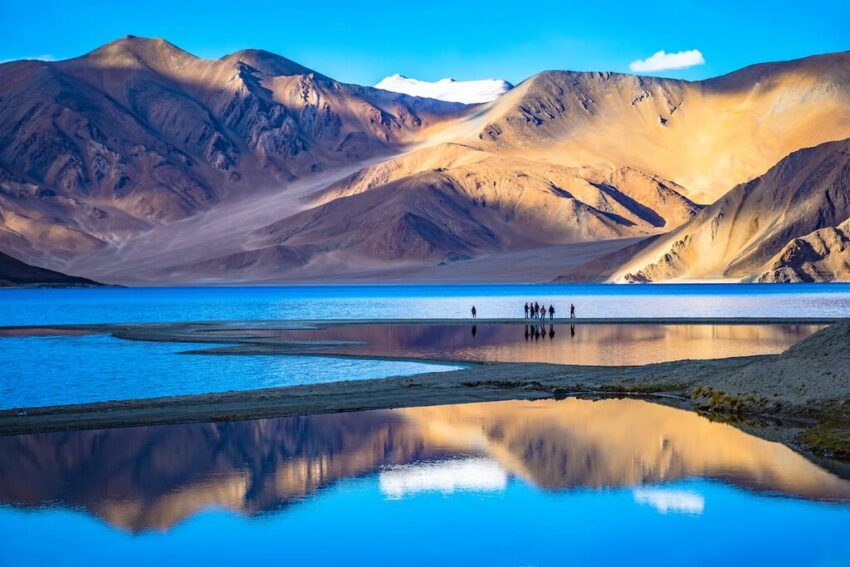Nestled between the towering Himalayas and the rugged Karakoram range, Ladakh Tourism offers travelers a rare blend of adventure, serenity, and cultural richness. Known as the “Land of High Passes,” Ladakh is one of India’s most captivating destinations—where dramatic landscapes meet ancient traditions and spiritual calm.
Whether you’re a thrill-seeker, a nature lover, or someone chasing quiet moments in monasteries, Ladakh has something for everyone. From shimmering lakes and snow-dusted peaks to vibrant festivals and warm-hearted locals, every corner of Ladakh tells a story worth experiencing.
🏔️ Why Ladakh Tourism Is So Unique
- High-altitude desert charm: Ladakh sits at over 10,000 feet above sea level, offering surreal views of barren mountains, deep valleys, and clear blue skies.
- Spiritual heritage: Home to centuries-old monasteries like Hemis, Thiksey, and Diskit, Ladakh is a living museum of Tibetan Buddhism.
- Adventure capital: Trekking, mountain biking, river rafting, and motorbiking through passes like Khardung La make Ladakh a magnet for adrenaline junkies.
- Eco-conscious travel: Ladakh Tourism has embraced sustainable practices, earning accolades like the “Best Adventure Destination” award in 2025.
📍 Must-Visit Places in Ladakh
Here are some iconic spots that define Ladakh Tourism:
1. Leh
The capital of Ladakh, Leh is the gateway to the region. Explore Leh Palace, Shanti Stupa, and bustling local markets. It’s also the base for acclimatization before heading to higher altitudes.
2. Pangong Lake
This mesmerizing blue lake stretches across India and China. Its color changes with the sunlight, making it a photographer’s dream. Camping near Pangong is a bucket-list experience.
3. Nubra Valley
Accessible via the Khardung La Pass, Nubra offers sand dunes, double-humped Bactrian camels, and the stunning Diskit Monastery. It’s a mix of desert and alpine beauty.
4. Tso Moriri
A quieter alternative to Pangong, Tso Moriri is a high-altitude lake surrounded by snow-capped peaks. It’s ideal for birdwatching and peaceful reflection.
5. Zanskar Valley
Remote and rugged, Zanskar is perfect for trekking and river rafting. The frozen Zanskar River trek (Chadar Trek) in winter is legendary among adventure seekers.
Sources:
🧘♂️ Cultural and Spiritual Experiences
Ladakh isn’t just about landscapes—it’s a deeply spiritual place. Monasteries here are not just tourist spots but active centers of learning and worship.
- Hemis Festival: Held in July, this vibrant celebration honors Guru Padmasambhava with masked dances and music.
- Thiksey Monastery: Resembling Tibet’s Potala Palace, it offers panoramic views and a serene atmosphere.
- Local homestays: Staying with Ladakhi families gives travelers a taste of traditional hospitality and cuisine.
🚴♀️ Adventure Activities in Ladakh
Ladakh Tourism is synonymous with high-altitude adventure. Here’s what you can try:
- Trekking: Popular trails include Markha Valley, Stok Kangri, and Sham Valley.
- Motorbiking: Ride through world-famous passes like Khardung La and Chang La.
- River rafting: The Zanskar and Indus rivers offer thrilling rapids.
- Camping: Sleep under starlit skies near lakes and valleys.
🗓️ Best Time to Visit Ladakh
Timing is crucial when planning a Ladakh trip. The region is open to tourists mainly from May to September, when roads are clear and weather is pleasant.
- May–June: Ideal for sightseeing and trekking.
- July–August: Great for festivals and cultural immersion.
- September: Fewer crowds, crisp air, and stunning autumn colors.
Winter (October to March) is harsh and mostly inaccessible, except for specialized treks like the Chadar Trek.
✈️ How to Reach Ladakh
- By Air: Leh Airport connects Ladakh to Delhi, Srinagar, and other major cities.
- By Road: Two scenic routes—Manali-Leh and Srinagar-Leh—are open from May to October. Both offer breathtaking views but require acclimatization.
- By Bike: A popular choice among adventure travelers, especially for the Manali-Leh route.
🧳 Travel Tips for Ladakh Tourism
- Acclimatize properly: Spend at least 24–48 hours in Leh before heading to higher altitudes.
- Pack smart: Layered clothing, sunscreen, lip balm, and sunglasses are essentials.
- Stay hydrated: The dry air and altitude can cause dehydration.
- Respect local culture: Dress modestly and ask before photographing people or religious sites.
- Go slow: Altitude sickness is real—listen to your body and avoid rushing.
🌱 Sustainable Travel in Ladakh
Ladakh Tourism is increasingly focused on eco-friendly practices:
- Avoid plastic: Carry reusable bottles and bags.
- Support local: Choose homestays, buy handicrafts, and eat local food.
- Leave no trace: Dispose of waste responsibly and stick to marked trails.
🏨 Where to Stay
Ladakh offers a range of accommodations:
|
Type |
Examples |
Ideal For |
|
Budget Hotels |
Guesthouses in Leh, Nubra |
Backpackers, solo travelers |
|
Mid-range |
Boutique hotels, eco-lodges |
Couples, small groups |
|
Luxury |
The Grand Dragon, Chamba Camp |
Families, premium travelers |
|
Homestays |
Local homes in villages |
Cultural immersion |
Sources:
📸 Final Thoughts: Ladakh Tourism Is More Than a Trip
Ladakh isn’t just a destination—it’s a feeling. It’s the silence of the mountains, the warmth of prayer flags fluttering in the wind, and the thrill of roads that touch the sky. Ladakh Tourism invites you to disconnect from the noise and reconnect with nature, culture, and yourself.
Whether you’re planning a spiritual retreat, an adventure-packed holiday, or a slow travel experience, Ladakh delivers memories that last a lifetime.

